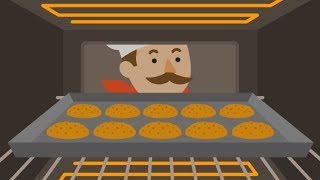(单词翻译:单击)
In a time-lapse video, it looks like a monster coming alive.
在慢镜头里,似乎一头野兽正在苏醒。
For a moment, it sits there innocuously. Then, ripples move across its surface.
刚开始,它只是无害的坐在那儿,然后,表面开始有了动静。
It bulges outwards, bursting with weird boils. It triples in volume.
它迅速膨胀,冒出许多奇怪的气泡。它的体积一下子膨胀了两倍。
Its color darkens ominously, and its surface hardens into an alien topography of peaks and craters.
颜色诡异的加深,表面变硬,如同外星球的坑坑洼洼。
Then, the kitchen timer dings. Your cookie is ready.
然后,厨房计时器响了。饼干做好了!
What happened inside that oven? Don't let the apron deceive you! Bakers are mad scientists.
烤箱里发生了什么?别被面包师的围裙唬住了。他们可是疯狂的科学家呢。
When you slide the pan into the oven,
当你把烤盘放进烤箱时,
you're setting off a series of chemical reactions that transform one substance, dough, into another, cookies.
你就开启了一系列化学反应:一种物质,面团,被转变成另一种物质,饼干。
When the dough reaches 92 degrees Fahrenheit, the butter inside melts, causing the dough to start spreading out.
当面团温度达到92华氏度时,里面的黄油融化,面团瘫软下来。
Butter is an emulsion, or mixture of two substances that don't want to stay together,
黄油是一种乳化剂,或者说是两种物质的混合物,这两种物质可不想呆在一起,
in this case, water and fat, along with some dairy solids that help hold them together.
在这里,指的是水和脂肪,一些乳脂块将水和脂肪混合在一起。
As the butter melts, its trapped water is released.
黄油融化时,里面水分被释放出来。
And as the cookie gets hotter, the water expands into steam.
饼干继续升温,水分膨胀成气体。
It pushes against the dough from the inside, trying to escape through the cookie walls like Ridley Scott's chest-bursting alien.
从里往外挤迫面团,想要冲出面团的束缚,就像雷德利·斯科特电影《异形》中的场景。
Your eggs may have been home to squirming salmonella bacteria.
面团里的鸡蛋可是沙门氏菌的窝巢。
An estimated 142,000 Americans are infected this way each year.
据估计,每年有14.2万美国人被这种细菌感染。
Though salmonella can live for weeks outside a living body and even survive freezing, 136 degrees is too hot for them.
虽然在沙门氏菌可以在体外,甚至冰冻的环境里存活数周,但烤箱内的136华氏度对他们来说太热了。
When your dough reaches that temperature, they die off.
当面团达到136华氏度时,这种细菌就死了。
You'll live to test your fate with a bite of raw dough you sneak from your next batch.
所以偷偷咬一口还没进烤箱的生面团是在拿生命冒险呢。
At 144 degrees, changes begin in the proteins, which come mostly from the eggs in your dough.
温度达到144华氏度时,蛋白质开始变化,蛋白质一般来源于面团中的鸡蛋。
Eggs are composed of dozens of different kinds of proteins, each sensitive to a different temperature.
鸡蛋含有很多种不同的蛋白质,每种的敏感温度不一样。

In an egg fresh from the hen, these proteins look like coiled up balls of string.
刚生出来的鸡蛋,里面的蛋白质像一团团的线。
When they're exposed to heat energy, the protein strings unfold and get tangled up with their neighbors.
加热鸡蛋时,蛋白质伸展开来,和周围的分子混在一起。
This linked structure makes the runny egg nearly solid, giving substance to squishy dough.
相互缠绕的蛋白质使流体的蛋几乎凝固,从而让湿乎乎的面团变硬。
Water boils away at 212 degrees, so like mud baking in the sun, your cookie gets dried out and it stiffens.
水分在212华氏度时完全变成蒸汽,就像阳光下炙烤的泥团,而你的饼干开始变干变硬。
Cracks spread across its surface.
表面布满小裂缝。
The steam that was bubbling inside evaporates, leaving behind airy pockets that make the cookie light and flaky.
沸腾的水滴蒸发,留下一个个小坑,使得饼干又薄又脆。
Helping this along is your leavening agent, sodium bicarbonate, or baking soda.
这一切都得益于发酵物,碳酸氢钠或烘焙苏打。
The sodium bicarbonate reacts with acids in the dough to create carbon dioxide gas, which makes airy pockets in your cookie.
碳酸氢钠和面团里的酸反应,产生二氧化碳气体,这些气体在饼干表面留下了一个个小坑。
Now, it's nearly ready for a refreshing dunk in a cool glass of milk.
现在,就快能蘸着牛奶享受你的饼干了。
One of science's tastiest reactions occurs at 310 degrees.
其中最增添美味的一个反应发生在310华氏度。
This is the temperature for Maillard reactions.
这个反应叫做美拉德反应。
Maillard reactions result when proteins and sugars break down and rearrange themselves, forming ring-like structures,
美拉德反应是由于蛋白质和糖分解,并重新结合形成环状结构,
which reflect light in a way that gives foods like Thanksgiving turkey and hamburgers their distinctive, rich brown color.
可以反射光,这样感恩节烤火鸡和汉堡包就拥有了独特诱人的褐色外表。
As this reaction occurs, it produces a range of flavor and aroma compounds,
该反应会产生大量美味又芬芳的化合物,
which also react with each other, forming even more complex tastes and smells.
其相互之间还在反应,产生更加浓郁的香气和味道。
Caramelization is the last reaction to take place inside your cookie.
焦糖化反应是你的饼干中最后发生的反应。
Caramelization is what happens when sugar molecules break down under high heat,
焦糖化反应是指糖分子在高温下分解,
forming the sweet, nutty, and slightly bitter flavor compounds that define, well, caramel.
产生甘甜、像坚果一样而且略发苦的化合物,也就是焦糖。
And, in fact, if your recipe calls for a 350 degree oven, it'll never happen, since caramelization starts at 356 degrees.
实际上,如果菜谱设定的烤箱温度为350华氏度,焦糖化反应就不会发生,因为这个反应发生温度为356华氏度。
If your ideal cookie is barely browned, like a Northeasterner on a beach vacation, you could have set your oven to 310 degrees.
要想使饼干颜色略微加深,如同来沙滩度假的东北地区的人,最好把烤箱温度设定为310华氏度。
If you like your cookies to have a nice tan, crank up the heat.
如果希望饼干呈现漂亮的棕褐色,那就调高温度。
Caramelization continues up to 390 degrees.
390华氏度内焦糖化反应都会继续。
And here's another trick: you don't need that kitchen timer; your nose is a sensitive scientific instrument.
这里还有个小窍门:你其实不用买计时器;你的鼻子就是灵敏的科学仪器。
When you smell the nutty, toasty aromas of the Maillard reaction and caramelization, your cookies are ready.
当你闻到来自于美兰德反应和焦糖化反应、坚果般温暖迷人的香味时,你的饼干就烤好了。
Grab your glass of milk, put your feet up, and reflect that science can be pretty sweet.
倒一杯牛奶,翘起脚,你会发现科学也能很甜蜜。


